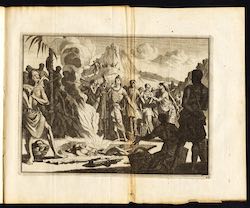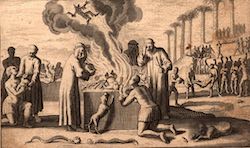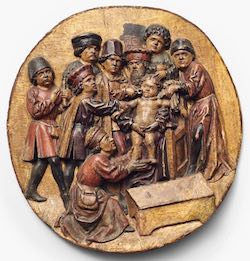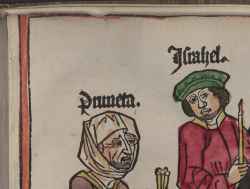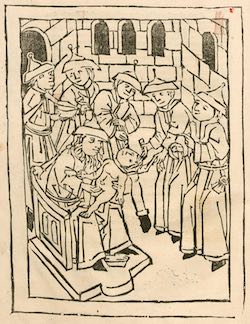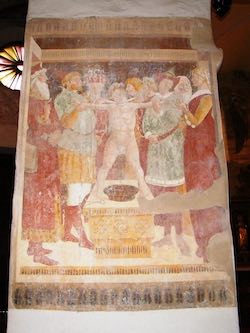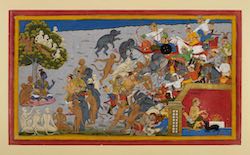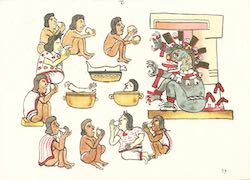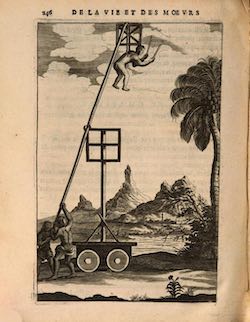Topic: 2. Sacrifice and religion: Comparisons, Antiquarians, Anthropology (16th-18th Century)
Religious sacrifices across various cultures and contexts sparked widespread interest in Early Modern Europe. As Christianity expanded into regions inhabited by "infidels" and "pagans", Europeans encountered a diverse array of sacrificial customs, ranging from the Sati rituals in India to the Aztec sacrifices in the Americas. This cross-cultural exposure captivated a wide audience, including theologians, philosophers, political thinkers, antiquarians, orientalists, missionaries, poets, artists, and even the general public. These encounters broadened the European understanding of sacrifice and led to a critical reassessment of classical and biblical sacrificial rites. This section includes:
- Sources: A selection of early modern printed materials, which include descriptions of the Americas, Asia, and Africa, alongside antiquarian and philological studies on religious sacrifice in classical antiquity and beyond. It also presents early modern works of ethnological observations and the first attempts to compare different sacrificial practices in various traditions and contexts, laying the groundwork for disciplines like the history of religions and anthropology.
- Iconographic Representations: A rich collection of images from the 16th to 18th centuries, illustrating a range of sacrificial rituals and practices as seen in different cultural and geographical contexts.
- Related Bibliography: An extensive bibliography spanning scholarly works from the 19th to 21st centuries, providing contemporary analyses and interpretations of these early studies and observations.
Naauw-keurige aanteekeningen van William Methold (1707)
from: van der Aa, P. Naauw-keurige aanteekeningen van William Methold, Presiden van de Engelsse Maatschappy, gehouden op sijn Voyagie, in het jaar 1619, Leiden, 1619
http://www.columbia.edu/itc/mealac/pritchett/00routesdata/1800_1899/hinduism/sati/sati.html
Narasimha Avatar of Vishn (1760)
from: Illustrated folio from a Bhagavata Purana (Ancient Stories of the Lord). Nurpur Fort, Nurpur, Himachal Pradesh, India
Nasli and Alice Heeramaneck Collection, Museum Associates Purchase, LACMA (M.82.42.8)
Native American priest sacrifices or eviscerates a victim before an idol. (1774)
from: Zárate, Agustin de, Histoire de la découverte et de la conquête du Perou, vol. I, Compagnie des libraires, 1774, p. 64
John Carter Brown Library
Native Americans [?] sacrifice children on an altar. Includes priests with knives who place the infants on a pyre. (1662)
from: Schultze, Gottfried, De nieuwe bereysde wereldt, Iohannes Tongerloo, La Hague, 1662, frontespiece
The John Carter Brown Library
Passover seder (1475)
from: Historie von Simon zu Trient [Bayerische StaatsBibliothek, 2 Inc.s.a. 62#Beibd], fol. 6v
Bayerische Staatsbibliothek, Munich
Purported Martyrdom of Simon of Trent (1465)
from: Tiberinus, Johannes Matthias, Passio Beati Simonis
Bayerische Staatsbibliothek, Munich
Purported Martyrdom of Simone of Trent (1475)
from: Historie von Simon zu Trient [Bayerische StaatsBibliothek, 2 Inc.s.a. 62#Beibd]
Bayerische Staatsbibliothek, Munich
Purported Martyrdom of Simone of Trent - Simone as Martyr (1475)
from: Historie von Simon zu Trient [Bayerische StaatsBibliothek, 2 Inc.s.a. 62#Beibd], fol. 4v
Bayerische Staatsbibliothek, Munich
Purported Martyrdom of Simone of Trient
Church of St Maria Rotonda. Pian Camuno, Val Camonica
Queen Nzinga sacrifices a man [illustration of Dapper Naukeurige beschrijvinge der Afrikaensche gewesten] (1676)
from: Olfert Dapper, Naukeurige beschrijvinge der Afrikaensche gewesten, Amsterdam, Meurs,1668, p. 238
Rāma sends out his entire army, headed by Lakṣmaṇa and Vibhīṣaṇa, to fight Indrajit at the Nikumbhilā grove, where he is performing more magical sacrifices. Indrajit is sacrificing to the fire again with a black goat, while around him a furious battle is raging between Lakṣmaṇa and his allies and the other demons. Vibhīṣaṇa has advised Rāma to send Lakṣmaṇa to finish off Indrajit at the place where he is performing his magical arts, before he can make himself even more powerful. Inscribed above Indrajit: Iṃdrajit. (ca 1653)
from: Ramayana [ms Add. 15297(1), fol. 115]
British Library, London [from Udaipur]
Religious practices of the native Americans of Peru. Priests sacrifice animals on a bonfire, throw rocks with serpents or snakes and animals painted on them, and eviscerate animals. (1671)
from: Arnoldus Montanus, De Nieuwe en Onbekende Weereld, Amsterdam, Jacob Meurs, 1671, p. 309
John Carter Brown Library
Ritual Feast with Human Linbs offered to a God [1526 - 1550]
from: Codex Magliabecchiano, c. 73r
Biblioteca Nazionale di Firenze, Florence
Ritual Human Sacrifice [1526 - 1550]
from: Codex Magliabecchiano, c. 70r
Biblioteca Nazionale di Firenze, Florence
Ritual killing of a goat and a fox during ceremonies in honor of Vishnu and Shiva (1670)
from: Abraham Rogerius, Le Théâtre de l’idolatrie ou la porte ouverte, Amsterdam, Jean Schipper, 1670, p. 224
Ritual Sacrifice during a Fight [1526 - 1550]
from: Codex Magliabecchiano, c. 18r
Biblioteca Nazionale di Firenze, Florence
Ritualistic hanging from a carriage during the procession, as part of ceremonies in honor of Ganga. Numerous goats were sacrificed during this event (1670)
from: Abraham Rogerius, Le Théâtre de l’idolatrie ou la porte ouverte, Amsterdam, Jean Schipper, 1670, p. 246


